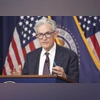The US's Federal Open Market Committee (FOMC) on Wednesday left its benchmark interest rate unchanged for the fourth time this year. Fed Chair Jerome Powell said “uncertainty is unusually elevated”, pointing to US President Donald Trump’s fast-shifting tariff agenda with major trade partners.
Holding steady, Powell added, keeps the central bank “well positioned to respond in a timely way” as economic conditions evolve, from global conflicts to domestic policy shifts.
Powell made clear that the next few months are likely to bring stronger goods-price inflation as levies work their way through supply chains. “Ultimately, the cost of the tariff has to be paid, and some of it will fall on the end consumer,” he told reporters, noting that many retailers are only now replacing pre-tariff inventory. “We do expect to see more of that over the course of the summer.”
Pointing to early signs — higher price tags on personal computers and audio-visual gear — he summed it up: “Someone has to pay for the tariffs."
Also Read
Treasury downplays consumer pain, hails revenue surge
Trump administration officials insist the impact on shoppers will be mild. US Treasury Secretary Scott Bessent argued on the “Pod Force One” podcast that recent price data show only a “0.1 percentage point” uptick and called dire forecasts “baseless", citing wage gains for hourly workers.
Customs receipts, however, tell another story: the Treasury collected a record $23 billion in May, nearly four times the haul a year earlier, as 25 per cent duties on steel and aluminium and higher rates on Chinese imports took hold, news agency Reuters reported.
Even though the Fed kept interest rates unchanged, it still expects to cut rates twice later this year. However, future rate cuts might happen more slowly because rising prices from tariffs could increase inflation risks. The headline rate of inflation ticked up to 2.4 per cent in May from 2.3 per cent, above the Fed’s 2 per cent goal but below earlier forecasts.
For now, the labour market remains “healthy and stable”, Powell said, with job creation continuing even as quit rates and vacancies soften. There is “nothing that's troubling at this time,” he added, predicting that artificial intelligence “should be creating jobs at the same time it may be replacing” others.
Political heat
Trump has repeatedly urged the Fed to move faster. “‘Too Late’ Jerome Powell is a FOOL, who doesn't have a clue. Other than that, I like him very much!” the US President posted on May 8, arguing that inflation is virtually nonexistent and “tariff money [is] pouring into the US”.
Powell has brushed off the criticism. After meeting Trump at the end of May, he reiterated that the FOMC “will make those decisions based solely on careful, objective, and non-political analysis". Asked again on Wednesday about the jabs, he replied: “That's what matters to us... That's all that matters".
Next steps: Watching prices — and politics
Powell acknowledged that some tariff worries have eased since April, when the White House floated even steeper duties — up to 145 per cent on Chinese goods — before dialing them back. Still, further talks with Beijing are expected “in about three weeks”, Bessent said, as both sides seek to revive a fragile trade truce.
With summer approaching, the Fed chair warned that fresh, tariff-laden shipments are just hitting US shores: “We’re beginning to see some effects, and we do expect to see more of them over coming months.” How high prices climb — and how consumers react — will help determine whether the promised rate cuts arrive on schedule or slide into 2026.
(With Reuters inputs)

)